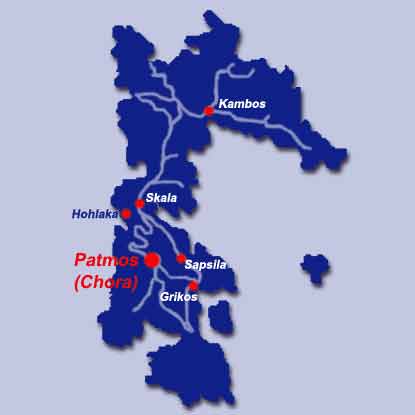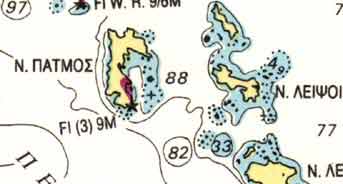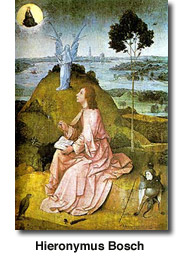
CLICK HERE TO CONTACT: Patmos Houses

IMPRESSIONS OF PATMOS © Randa Bishop One of the original 12, or Dodecanese, Greek islands, Patmos is rich in both history and natural beauty. The small, hilly island (34.6 square kilometers) was populated from as early as 500 BC by Dorians, next the Ionians, and then the Romans from the 2nd century BC. The earliest known temples on the island were the 4th century BC sanctuary of Diana and it is suspected that the name Patmos may derive from Latmos or Mt. Latmos of Turkey, where the goddess Diana was worshipped.
During the period of Roman rule the island fell into decline, the population decreased, and the island was used as a place of banishment for criminals and political and religious troublemakers. In 95 AD, St. John the Theologian - one of the twelve disciples of Jesus -was sent into exile on the island. St. John remained on the island for 18 months during which time he lived in a cave below the hilltop temple of Diana. In this cave exists a fissure, or small hole in the rock wall, from which issued a collection of oracular messages that St. John transcribed as the Biblical chapter of Revelations. During his time in the sacred cave, now known as the Holy Grotto of the Revelation, St. John also composed the Fourth Gospel. In 313 AD, Christianity was officially recognized as the religion of the Roman Empire and from this time the new faith spread rapidly throughout the Greek islands. The eastern Christian empire of Byzantium exercised control over the isle of Patmos and in the 4th century the ancient shrine of Diana was torn down. Directly upon its foundations was erected a church dedicated to St. John but this church was itself destroyed sometime between the 6th and 9th centuries when the island was subjected to frequent raids by the Arabs. Left deserted after these raids, Patmos next entered history in 1088 when a Byzantine emperor granted the island to the monk Christodolous, whose intention it was to establish a monastery. Built upon the remains of the old church and the older shrine of Diana, the monastery of St. John has been in continuous operation for over 900 years. Subjected to raids by Saracens and Norman pirates during the 11th and 12th centuries, the monastery was frequently enlarged and fortified, giving it the castle-like appearance it retains today. The small town of Hora surrounding the monastery dates mostly from the mid 17th century and its labyrinthine street arrangement was purposefully designed to confuse pirates intent on raiding the town and monastery. Author: Martin Gray St. John the Evangelist (Apostle) is a disciple of Christ; he followed Jesus after the miraculous draught of fishes on the Sea of Galilee and was with him at the most important moments. At the foot of the Cross he supported the failing Virgin. After the Apostles scattered, he traveled to Asia and settled in Ephesus with the Virgin. There he was arrested and thrown into burning oil, but was unhurt. Under Emperor Dominitian he was exiled to island Patmos, where in the company of an eagle he wrote the Revelations. After amnesty he returned to Ephesus, where he composed his Gospel. There he survived an ordeal set by the high priest of Ephesus: he was unaffected by a beverage concocted from snake’s venom, when offered a chalice, St. John blessed it, and the venom in the form of a snake, was miraculously drawn from the liquid. A legend also says that he was lifted up in an Assumption by an angel. He is the patron saint of booksellers. In fine arts he is often depicted with an Eagle, book (Gospel or Revelation), snake or dragon emerging from a cup or chalice.
 Patmos Navigation Map
TRIBUTE to ROBERT LAX © James J. Uebbing On my first visit to Patmos I spent most of my evenings in Lax's little house above the bay, chatting amiably over cakes and tea. I was rarely the only guest. Lax used to have visitors nearly every night during the summers. Some made their way to Patmos for a few days, some stayed for months or even years. A few have never left. Today he is more retiring, but he still corresponds with the various students, academics, psychologists, and priests who have found him out at one point or another. He will enclose a drawing or a poem with his letters, which are prompt but rarely very long and always signed with a yellow dot. "What's the dot for?" I asked him, after a few years. "Nothing at all."
Click
to see "The Patmos Collection"
"The Patmos Collection" Click to see Artwork depicting St. John of Patmos CLICK HERE TO CONTACT: patmos@pobox.com All Images, Text and Website ©1999-2008 Patmos Properties, All rights reserved. Patmos pages Established 1999Please come back soon and visit.
|
|

